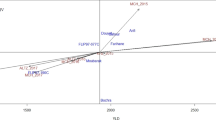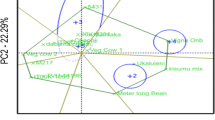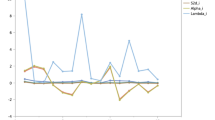Abstract
Multi-environment trials (MET) play an important role in selecting the best cultivars and/or agronomic practices to be used in future years at different locations by assessing a cultivar's stability across environments before its commercial release. Objective of this study is to identify chickpea (Cicer arietinum L.) genotypes that have high yield and stable performance across different locations. The genotypes were developed by various breeders at different research institutes/stations of Iran and the International Center for Agricultural Research in Dray Areas (ICARDA), Syria. Several statistical methods were used to evaluate phenotypic stability of these test chickpea genotypes. The 17 genotypes were tested at six different research stations for two years in Iran. Three non-parametric statistical test of significance for genotype × environment (GE) interaction and ten nonparametric measures of stability analyses were used to identify stable genotypes across the 16 environments. The non-parametric measures (Kubinger, Hildebrand and Kroon/Van der) for G × E interaction were highly significant (P < 0.01), suggesting differential responses of the genotypes to the test environments. Based on high values of nonparametric superiority measure (Fox et al. 1990) and low values of Kang's (1988) rank-sum stability parameters, Flip 94-123C was identified as the most stable genotype. These non parametric parameters were observed to be associated with high mean yield. However, the other nonparametric methods were not positively correlated with mean yield and were therefore not used in classifying the genotypes. Simple correlation coefficients using Spearman’s rank correlation, calculated using ranks was used to measure the relationship between the stability parameters. To understand the nature of relationships among the nonparametric methods, a hierarchical cluster analysis based on non weighted values of genotypes, was performed. The 10 stability parameters fell into three groups.


Similar content being viewed by others
References
Arshad M, Bakhsh A, Haqqani AM, Bashir M (2003). Genotype-environment interaction for grain yield in chickpea (Cicer Arietinum L.). Pak. J Bot 35(2):181–186
Comstock RE, Moll PH (1963) Genotype-environment interaction. In: Symposium on statistical genetics and plant breeding, NAS-NRC Publication, pp 164–196
De Kroon J, van der Laan P (1981) Distribution-free test procedures in two-way layouts: a concept of rank-interaction. Stat Neerl 35:189–213
FAO (2001) UN Food and Agriculture Organization. Rome. Italy
FAO (2004). Production year book, 2003. Food and Agricultural Organization
Finlay KW, Wilkinson GN (1963) The analysis of adaptation in a plant breeding program. Aust J Agric Res 14:742–754
Fox PN, Skovmand B, Thompson BK, Braun HJ, Cormier R (1990) Yield and adaptation of hexaploid spring triticale. Euphytica 47:57–64
Hildebrand H (1980) Asymptotosch Verteilungsfreie Rangtests in linearen Modellen. Med Inform Stak 17:344–349
Huehn VM (1979) Beitrage zur erfassung der phanotypischen stabilitat. EDV Med Biol 10:112–117
Huehn M (1990) Nonparametric measures of phenotypic stability: Part 1. Theory. Euphytica 47:189–194
Huehn M, Leon J (1995) Nonparametric analysis of cultivar performance trials: experimental results and comparison of different procedures based on ranks. Agron J 87:627–632
Jauregui B, Flores F, Gil J (1996) Use of AMMI analysis to elucidate genotype–environment interaction in chickpea (Cicer Arietinum L.). Legume Research 19(2):117–123
Kang MS (1988) A rank–sum method for selecting high-yielding, stable corn genotypes. Cereal Res Commun 16:113–115
Kang MS (1990) Genotype-by-environment interaction and plant breeding. Louisana State University Agricultural Center, Baton Rouge, LA, USA, pp 392
Kang MS, Pham HN (1991) Simultaneous selection for high yielding and stable crop genotypes. Agron J 83:161–165
Ketata H, Yan SK, Nachit M (1989) Relative consistency performance across environments. International symposium on physiology and breeding of winter cereals for stressed mediterranean environments. Montpellier, July 3–6, 1989
Kubinger KD (1986) A note on non-parametric tests for the interaction on two-way layouts. Biom J 28:67–72
Lin CS, Binns MR, Lefkovitch LP (1986) Stability analysis: Where do we stand? Crop Sci 26:894–900
Mekbib F (2003) Yield stability in common bean (Phaseolus vulgaris L.) genotypes. Euphytica 130:147–153
Mungomery VE, Shorter R, Byth DE (1974) Genotype × environment interactions and environmental adaptation. 1. Pattern analysis-application to soya bean populations. Aust J Agric Res 25:59–72
Nassar R, Huehn M (1987) Studies on estimation of phenotypic stability: tests of significance for nonparametric measures of phenotypic stability. Biometrics 43:45–53
Pritts M, Luby J (1990) Stability indices for horticultural crops. HortScience 25:740–745
Roemer T (1917) Sin die ertragsreichen sorten ertragssicherer. Mitt DLG 32:87–89
Sabaghnia N, Dehghani H, Sbaghpour H (2005) Nonparametric methods for interpreting genotype × environment interaction of lentil genotypes. Crop Sci 46:1100–1106
Sabaghpour SH, Sadeghi E, Malhotra RS (2003) Present status and future prospects of chickpea cultivation in Iran. international chickpea conference, Raipur, Chhattisgarh, India, pp 436–443
SAS Institute (1996) SAS/STAT user’s guide. v. 6 4th ed. SAS Inst., Cary, NC
Scapim CA, Oliveira VR, Braccini1 AL, Cruz CD, Andrade CAB, Vidigal MCG (2000) Yield stability in maize (Zea mays L.) and correlations among the parameters of the Eberhart & Russell, Lin & Binns and Huehn models. Genet Mol Biol 23:387–393
Shukla GK (1972) Some aspects of partitioning genotype-environmental components of variability. Heredity 28:237–245
Thennarasu K (1995) On certain non-parametric procedures for studying genotype-environment interactions and yield stability. Ph.D. Theses P J School IARI, New Dehli
Truberg B, Huehn M (2000) Contribution to the analysis of genotype by environment interactions: comparison of different parametric and nonparametric tests for interactions with emphasis on crossover interactions. Agron Crop Sci 185:267–274
Ward JH (1963) Hierarchical grouping to optimize an objective function. J Am Stat Assoc 58:236–224
Acknowledgements
Thanks to Profs. M. S. Kang and H. Y. Lu for their helpful comments and Prof. Leon for SAS programs. Our sincere gratitude also goes to the Iranian Agricultural Research Organization and its Agricultural Research Stations for providing plant materials, experimental sites and technical assistance.
Author information
Authors and Affiliations
Corresponding author
Rights and permissions
About this article
Cite this article
Segherloo, A.E., Sabaghpour, S.H., Dehghani, H. et al. Non-parametric measures of phenotypic stability in chickpea genotypes (Cicer arietinum L.). Euphytica 162, 221–229 (2008). https://doi.org/10.1007/s10681-007-9552-x
Received:
Accepted:
Published:
Issue Date:
DOI: https://doi.org/10.1007/s10681-007-9552-x




